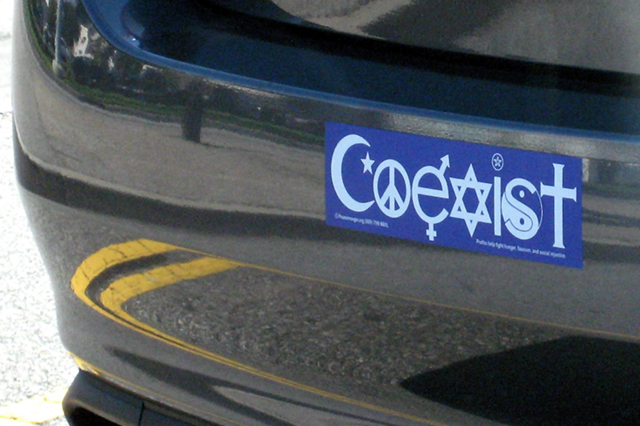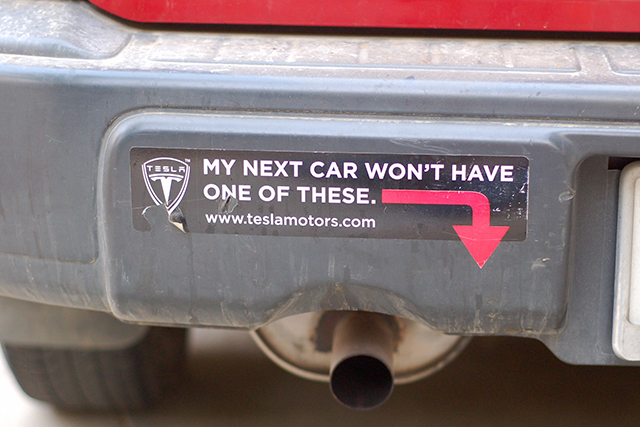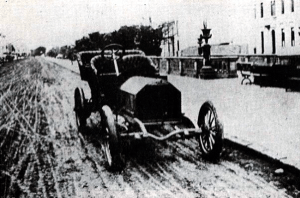Bumper stickers. Some people love them, some people loathe them. But nobody can argue that they’re everywhere.
So how did these ubiquitous pieces of advertising come about? And how have they managed to last the test of time? Let’s take a look.
The Bumper
The idea of using a vehicle for advertisement was around before the automobile was even invented. In the horse-and-buggy days, it was common for people to adorn horsefly nets with advertising slogans.
The trend continued when automobiles came around. But almost all early cars lacked bumpers. The safety feature wasn’t widely adopted until 1927, when Ford released the Model A. Drivers decorated their bumpers with homemade signs. But these were usually made of cardboard or metal and attached using wire. Needless to say, they didn’t last very long.
The Sticker
The bumper sticker as we know it today can be traced back to a screen printer in Kansas City, Mo. named Forrest P. Gill. In the 1940s, Gill found himself with a surplus of two wartime technologies: adhesive-backed paper and fluorescent paint. He combined the two and the bumper sticker was born. His new creation was a significant improvement over handmade signs that fell off cars or easily wore down.
The first early adopters of bumper stickers were tourist sites. Instead of having a single sign on the side of the road, destinations now had countless ads traveling across the country. Gill’s first large volume request was 25,000 bumper stickers for Marine Gardens in Clearwater, Fl. (The company Gill founded is still around today and still selling bumper stickers.)
The popularity of bumper stickers took a major step forward during the 1952 presidential election between Dwight Eisenhower and Adlai Stevenson. It was the first election to include the use of bumper stickers as advertising materials. They have since been used in every U.S. presidential election. To this day, political advertising remains a mainstay use of bumper stickers.
Bumper Stickers Today
Bumper stickers have evolved over the years to include decals and placards. The most famous of the latter is the “Baby on Board” sign. Interestingly enough, the ubiquitous sign was developed and sold by a man without children.
In 1984, Massachusetts businessman Michael Lerner was asked by a friend for advice on how to market the signs. Lerner wasn’t a father but he had recently endured a harrowing experience driving his young nephew. “People were tailgating me and cutting me off,” he told the Wall Street Journal. “For the first time, I felt like a parent feels when they have a kid in the car.”
Lerner tweaked the design, creating the now-famous black-and-yellow diamond sign. “Baby on Board” was an immediate hit. Less than a year after hitting the market, Lerner had sold 3 million signs.
“Baby on Board” isn’t the only popular sign or sticker to last the test of time. Others are religious (the ichthys, “Coexist”), familial (“My Child is an Honor Student,” the stick figure family), and safety related (“Slow Down, Move Over,” “School’s Open – Drive Carefully”).

No Laughing Matter
As innocent as bumper stickers can be, they have not been without their fair share of controversy. In fact, in 1991, they were the topic of a legal case that reached the Georgia Supreme Court.
In Cunningham v. the State, a Georgia resident had been caught having a bumper sticker on his car that contained an expletive. He was charged with violating a state law that prohibited car owners from attaching “any sticker, decal, emblem, or other device containing profane or lewd words.” The owner argued this law was unconstitutional. The court agreed, stating that the law violated the 1st and 14th Amendments. Thus, the humble bumper sticker became protected by freedom of speech.
A 2008 study by Colorado State University found that car owners with bumper stickers or window decals tend to be more aggressive drivers. Researchers also discovered the message of the sticker was irrelevant. A driver with a “Peace and Love” sticker was as likely to be an aggressive driver than one with a more hostile sticker.
Which bumper stickers do you see most often? Which ones do you like and which are you tired of? Let us know in the comments below!
82 Thoughts on “The Unique History of Bumper Stickers”
Leave A Comment
Comments are subject to moderation and may or may not be published at the editor’s discretion. Only comments that are relevant to the article and add value to the Your AAA community will be considered. Comments may be edited for clarity and length.















I’ve got one that says “DON’T STEAL THE GOVERNMENT HATES COMPETITION!” I won’t dare put it on my car, for fear someone will steal it! I put it in my window when I drive to city hall to pay my property taxes though!
“Don’t always believe what you think”
I don’t put them on my own car but I do enjoy reading them.
One I saw recently; “I have no idea where I’m going”. Another good one; “Life is a bitch and so am I”.
Thank you. I appreciated the entire article and replies. I just screamed and I am 77 years old.
Bumpah stickah in Boston: “Drive like crazy and you’ll get there”
“So many pedestrians, so little time” 🙂
I drive a company car so no bumper stickers. Used to have an Obama sticker and a guy on interstate gave me the finger. It’s frightening that people feel so threatened by my free speech expression and who is he to impose his will on me? Maybe he should visit North Korea and try to express his sentiments. Bet there’s no bumper stickers in North Korea.
Only love beats milk. Saw this , Coolidge Corner, Brookline MA, 1970. Plain bumper sticker, no attribution to any organization.
2 that I have seen and have stayed in my brain are:
‘Ever stop to think and forget to start again?’
‘Do not meddle in the affairs of dragons… for you are crunchy and good with Ketchup’
Sorry for driving so close in front of you.
When I was living in Stamford, CT, I always wanted a bumper sticker that said “Honk If You’re Rude”, but the closest thing I could find was “Honk If You’re Stupid”. I had that on my car until it got totalled. Drivers would incessantly honk their horns outside my apartment building at all hours of the night for no legitimate reason. Now that I live in Vermont, the only people who honk their horns are rude people from out of state.
bumper stickers are an inexpensive disguise for minor body damage.
” It’s time you pull over and change the air in your head “
While I can enjoy a witty bumper sticker, I stopped putting them on my car when a college buddy of mine explained that unless it is a totally neutral concept (and if that is the case, why bother?), then no matter what idea you are espousing, there is always going to be someone with an opposing point of view, even if it is only that you don’t care about anyone else’s (“No one cares who you voted for.”). And therein is the potential for your car getting vandalized. Is expressing your political persuasion REALLY worth the risk of getting your car keyed or worse?
One I saw back in the 80’s- This car fell off of Mount Washington
My favorite Eve was framed.
Never saw a bumper sticker in Europe where I grew up, just the national decals which we needed when travelling out of the country. I now have those on my car here, so we can connect with others from the old country.
I like “hang up and drive.” But I only use decals, because bumper stickers are too hard to get off!
The comment about drivers with bumper stickers being more aggressive reminds me of a joke about a woman who was pulled over for yelling and making obscene gestures at other drivers. The cop who asked for her license and registration said, “Oh, is this your car? When I saw the ‘Jesus saves’ bumper sticker and the ‘Choose Life’ plates, and saw how you were treating other drivers, I figured the car must be stolen.”
My favorite: NO FARMS, NO FARM GIRLS
My favorite was on a rusty old pickup truck, it said
“Honk if Parts Fall Off”
Up in Maine, where braking for a 1 ton moose in the road could save your life, there is this dry humorous version.. – Brake for Moose, it could be my Wife.
My favorites. “If you can read this you’re too close”. and “Baby on board.” Wish I could find them again.
Public radio bumper sticker seen in Rhode Island…..
NPAh
my favorite: test your airbags here…
My favorite bumper sticker is: “All men are idiots and my husband is their king!”
I personally like the sarcastic ones such as My Kid Beat Up Your Honor Student and My Other Bumper Sticker is also Tolerant and Condescending. I don’t have bumper stickers on my car, though I’ve often considered printing one up that says Nobody Cares Who You Voted For.
I always have an American flag or Captain America star on my back window. My pet peeve is when someone slaps it on crooked. I love seeing a car with dozens of bumper stickers. It makes me feel good!
My all time favorite is a play on “I Brake for Animals”. I came across an elderly driver who was not afraid to share a laugh at his own expense; had this on his bumper “I Brake for No Apparent Reason”
Favorite bumper sticker ever was created and distributed by friend in late 70’s during the time of the T.V. show “SOAP” with Billy Crystal. It read “FREE JESSICA TATE”.
My favorite bumper sticker is:
If you don’t like the way I drive stay off the sidewalk!
I guess I’m a lunatic. I have too many bumper stickers to count. Once i broke the ice the first sticker on my bright red, shiny Focus hatchback, I couldn’t stop. My first one said, “Everyone Does Better When Everyone Does Better”. After 2016, there were many msgs placed that are not necessary anymore. It appears I need to get a new car with fresh bumpers! The first sticker remains my favorite.
I liked “Gandalf For President” & “Frodo Lives!” from the sixties and the Watergate era classic: “Don’t Blame Me; I’m From Massachusetts!”
What am I supposed to “moderate”? These were actual and very funny bumper stickers in the 1960s and 1970s around metro West Boston. MA was the only state not to vote for Nixon in the 1972 election.
as another Massachusetts driver during the Nixon Watergate era- a take off on the Nixon elections stickers “Nixon’s the One!”, became “NOW Nixon’s the One!”
When motivated, I print my own bumper stickers (pigmented ink on gummed paper, covered with plastic laminate). During the Iraq invasion “SHOW US THE WMD, GEORGE” graced my bumper (referring to the non-existent “weapons of mass destruction”). It generated mixed reactions, depending on the viewer’s political views.
I always liked the “Mean People S*ck!” bumper sticker until I saw the same on that was clipped to read only “People S*ck!”
From way back… “Experience is what you get when you fail to do what you set out to do”
I only have one bumper sticker on my car and I love it. It reminds me of who I am and hopefully gives everyone a chuckle. It says, “Caution: driver singing.” I thought about putting my alma mater on my car or my kids colleges, but haven’t made the plunge.
Years ago I saw one on an old junky looking car that read – My other car is a piece of
S _ _ t also!
Thanks for the history of the bumper sticker, it was a good read. I was surprised that there was no mention of the bumper stickers used in Forrest Gump – “It Happens” and the smiley face.
One of my favorites…..”The next time you’re down in the dumps….pick me up a tire”
I like Catholic Christian bumper stickers. I have one that simply lists the local Catholic radio station. I have another that I made with 3 inch magnets that says “Con Jesus y Maria mi vida es alegria.” People love it because its home made.
Bumper “stickers” are a more recent
development. I remember the ads that attached to the bumper using metal wires. My father would not put them on our car in the 1950’s because he said the wires would rust and damage the bumper.
My hands down favorite is, ‘God is coming–and is she pissed!’
In about 1956, my family vacationed in the Adirondacks. Got bumper ads (cardboard, affixed to bumper with wire) from every attraction we visited. Loved seeing other cars with the same ones. Lasted till the car wash.
I liked “honk for Jesus” from many years ago
Business not noisiness
I have positive bumper stickers all over the back of my 2005 Honda and joke that they hold it together. During difficult times in this country, it’s great when you get a thumbs up. I must be a statistical anomaly because I’m not a wild or aggressive driver.
My favorite and one I’ve been meaning to put on my bumper is “The closer you get, the slower I go”.
If you buy 12 bumper stickers, you get a free Subaru or Prius!
As an auto auction owner, I sell in excess of 10,000 vehicles a year and have been the business for 51 years. I look for the AAA sticker as a tip-off that the vehicle was more than likely well cared for by an elderly owner. Not sure if any of the younger folks learning the noisiness have picked up on this.
As a knockoff of “Visualize World Peace” …
VISUALIZE GRILLED CHEESE
I read a story in the New York Times years ago that said if you had 7 or more bumper sticker that you were a lunatic
Bumper stickers were always too small for me, on my 2013 LEAF I made Bumper Magnets with 3” letters.
You can find dozens of pics of my car if you search for google images of UBUYGAS
My new car only has a couple stickers on either side of my license plate. Search for NAY2GAS to see that car.
Honk if your horn is broken.
Similar horn reference: “Horn is broken. Watch for Finger.”
My favorite :
Keep honking – I’m reloading
My favorite is “I hate bumper stickers”.
Boycott shampoo, demand real poo.
I once made my own bumper sticker when I worked in a print shop, after seeing one of those ubiquitous “This car climbed Mt. Washington” stickers. I changed the name of the mountain so that it said “This car climbed Mt. Everest,” with the words superimposed over a picture of that mountain. It drew a lot of attention, most of it positive.
Hi Steven! Love the ingenuity and thank you for commenting! -MM
A co-worker in a company I worked for years ago had a bumper sticker on his car that is an all-time favorite of mine: “I feel much better now that I’ve given up hope”.
Hi Ann Marie! That has to be a qualification for a bumper sticker, memorable years later! Thanks! -MM
I have only 1 bumper sticker on my care – EVER. It shows the “Hi Neighbor” from the Narragansett Brewery, originally manufactured outside of Providence RI. R.I.ers know Gansetts as much as they know Coffee Milk, Dels Lemonade, and NY System hot weiners..
Hi Robert! We love to see RI references on the road! Thank you for your comment -MM
And then there was the infamous “S#!T Happens”. My dad reprimanded me about this one in the 80’s.
Best one I’ve seen is “Dogs come when you call them – Cats have answering machines”
If You Can Read This You’re Too Close is my favorite. There’s lots of drivers who will almost climb over the car in front of them. I promise I’ll pull over as fast as I can. Grace, Mystic CT
The company Mr. Gill founded exists today as Gill Studios in Shawnee Mission, Kansas. I have been placing orders for bumper stickers, signs, lapel stickers, magnets, etc. since 1995. They are fantastic people to work with, the quality of their products is unmatched and they are a proud union company as is my own.
Hi Kathy! Thank you for your added insight into the company! Great to know they have more to offer than bumper stickers. – MM
I want to do a fundraiser for my church.what amount should I start at? What price should I charge?
What is your minimum amount required? I love bumper stickers!!?
I don’t like to clutter up my vehicle with bumper stickers..actually,the only one I have is one from aaa that I get every year with my membership!
Hi Susan! Love it! Thanks for being a loyal member! -MM
My favorite is: Jesus Saves Espo scores on the rebound! (This is in reference to the Boston Bruins in the early 1970’s)
Hi John, Phil Esposito nod appreciated! Thanks for your comment -MM
“Jesus is coming.. and, boy is he pissed!”
Back in the gas shortage years in the early ’70s, there was Eat More Beans, America Needs The Gas. And on a more political side, when I first went to college in 1971 when America Love It Or Leave It was popular, I saw America Change It Or Lose It. Relevant 50 years later?
My all time favorite bumper sticker read “STAY ALERT, AMERICA NEEDS MORE LERTS”
Hi Harry! Love that one! Thanks for commenting -MM
Honk if something falls off
In the gas shortage in the mid-1970’s, the New England area had a gasoline, power, and fuel oil shortage, especially in the Winter. The oil-rich Southern states, where many people are skeptical of Yankees anyway. A popular bumper sticker was, “Let the Bastards Freeze in the Dark.”
Herb Caen, the San Francisco Chronicle Columnist (“Bagdad by the Bay”) used to call them Bumper Snickers.
Hi David! Thanks for your comment, glad you visited! – MM